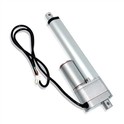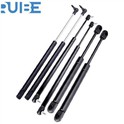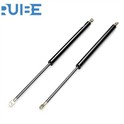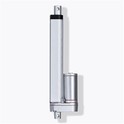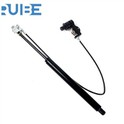In the realm of marine applications, the choice of equipment is crucial due to the harsh and demanding environment. One question that often arises is whether a 12V linear actuator can be used in such settings. As a supplier of 12V Linear Actuator, I'm well - versed in the capabilities and limitations of these devices, and I'll delve into this topic to provide a comprehensive answer.
Understanding 12V Linear Actuators
Before we assess their suitability for marine applications, let's understand what 12V linear actuators are. A linear actuator is a device that converts rotational motion into linear motion. The 12V rating indicates the voltage at which the actuator operates. These actuators are popular due to their compact size, relatively simple installation, and ease of control. They can be found in a wide range of applications, from small home automation projects to industrial machinery.
Advantages of Using 12V Linear Actuators in Marine Applications
Power Efficiency
Marine vessels often rely on a 12V DC power system, which is commonly provided by batteries. A 12V linear actuator can directly tap into this existing power source without the need for complex voltage conversion. This not only simplifies the electrical setup but also improves overall power efficiency. Since power is a precious commodity on a boat, using a 12V actuator that aligns with the onboard power system helps conserve energy and extend battery life.
Compact Size
Space is at a premium on marine vessels. 12V linear actuators are typically compact in design, making them ideal for applications where there is limited room for equipment installation. Whether it's for adjusting a small hatch, controlling a ventilation flap, or operating a minor steering mechanism, the small footprint of these actuators allows for flexible placement without taking up excessive space.
Precise Control
Many 12V linear actuators offer precise control over the linear motion. This is particularly useful in marine applications where accurate positioning is required. For example, in a sailboat, an actuator can be used to precisely adjust the tension of the sails, optimizing the vessel's performance in different wind conditions. The ability to make fine - tuned adjustments enhances the overall functionality and safety of the marine equipment.
Challenges of Using 12V Linear Actuators in Marine Applications
Corrosion Resistance
The marine environment is highly corrosive due to the presence of saltwater, humidity, and various chemicals. Standard 12V linear actuators may not be equipped to withstand these harsh conditions. Saltwater can cause rust and corrosion on the actuator's metal components, leading to premature failure. To overcome this challenge, it is essential to choose actuators that are specifically designed with corrosion - resistant materials. Some actuators come with a protective coating, such as stainless steel or a special polymer, which helps prevent corrosion and extends the actuator's lifespan.
Waterproofing
Water ingress is a significant concern in marine applications. If water seeps into the actuator, it can damage the electrical components and cause malfunctions. A 12V linear actuator used in a marine setting must have a high level of waterproofing. Actuators with an IP (Ingress Protection) rating of at least IP65 or higher are recommended. The IP65 rating means that the actuator is dust - tight and protected against low - pressure water jets from any direction.
Load Capacity
Marine applications can impose varying load requirements on the actuator. Some tasks, such as opening heavy hatches or operating large - scale steering systems, may require a higher load - bearing capacity than what a standard 12V linear actuator can offer. It's crucial to carefully assess the load requirements of the specific marine application and choose an actuator with an appropriate load capacity. In some cases, multiple actuators may need to be used in parallel to handle heavier loads.


Applications of 12V Linear Actuators in Marine Settings
Hatch and Door Operations
12V linear actuators can be used to automate the opening and closing of hatches and doors on a marine vessel. This not only provides convenience for the crew but also enhances safety by ensuring that hatches and doors are properly sealed to prevent water ingress. The compact size of the actuators allows for easy installation in the limited space around hatches and doors.
Ventilation Systems
Proper ventilation is essential on a boat to maintain air quality and prevent the buildup of moisture and harmful gases. 12V linear actuators can be used to control the opening and closing of ventilation flaps, allowing for adjustable airflow. This helps in regulating the temperature and humidity inside the vessel, creating a more comfortable and safe environment for the occupants.
Steering Systems (Minor Applications)
In smaller boats or as part of auxiliary steering mechanisms, 12V linear actuators can be used to provide some degree of steering control. They can assist in making minor adjustments to the rudder or other steering components. However, for larger vessels or primary steering systems, more powerful actuators may be required.
Comparing with Other Actuator Types
Hydraulic Actuators
Hydraulic actuators are known for their high load - bearing capacity and ability to handle heavy - duty applications. However, they are also more complex and require a hydraulic fluid system, which can be bulky and maintenance - intensive. In contrast, 12V linear actuators are simpler, more compact, and easier to install and maintain. While they may not have the same load - handling capabilities as hydraulic actuators, they are a better choice for smaller - scale marine applications.
Pneumatic Actuators
Pneumatic actuators use compressed air to generate linear motion. They are relatively fast and can provide a good amount of force. However, they require an air compressor and a pneumatic system, which adds to the complexity and cost of the installation. 12V linear actuators, on the other hand, are more straightforward and can directly utilize the existing 12V power system on a boat, making them a more cost - effective and practical option for many marine applications.
Conclusion
In conclusion, a 12V linear actuator can indeed be used in marine applications, provided that the specific challenges of the marine environment are addressed. The advantages of power efficiency, compact size, and precise control make them a viable option for a variety of tasks on a marine vessel. However, it is crucial to select actuators with appropriate corrosion resistance, waterproofing, and load - bearing capacity.
As a supplier of 12V Linear Actuators, we offer a range of products designed to meet the unique requirements of marine applications. Our actuators are made from high - quality, corrosion - resistant materials and have a high IP rating to ensure reliable performance in harsh marine conditions. We also provide actuators for other applications such as Linear Actuator for Solar Tracker and Linear Actuator for Trunk Lid.
If you are considering using a 12V linear actuator in your marine project, we invite you to contact us for further information and to discuss your specific needs. Our team of experts is ready to assist you in selecting the right actuator for your application and can provide valuable advice on installation and maintenance. We look forward to the opportunity to work with you and contribute to the success of your marine project.
References
- "Marine Electrical Systems Handbook" by Various Authors
- "Actuators: Principles, Types, and Applications" by Industry Experts

